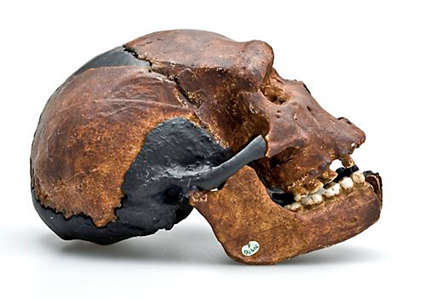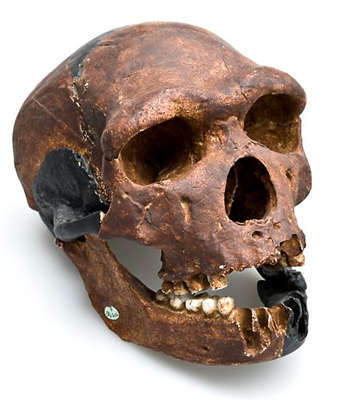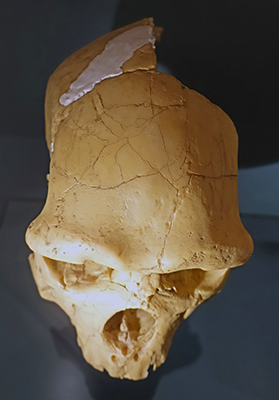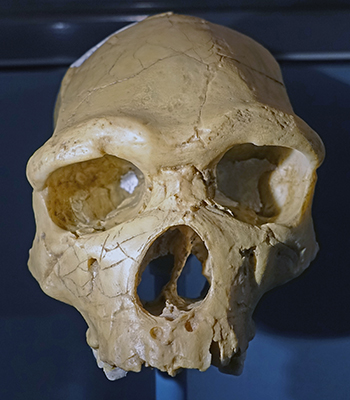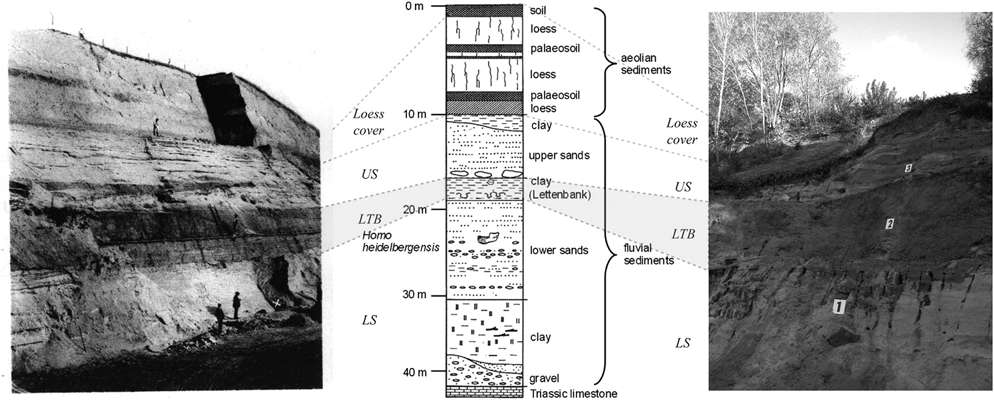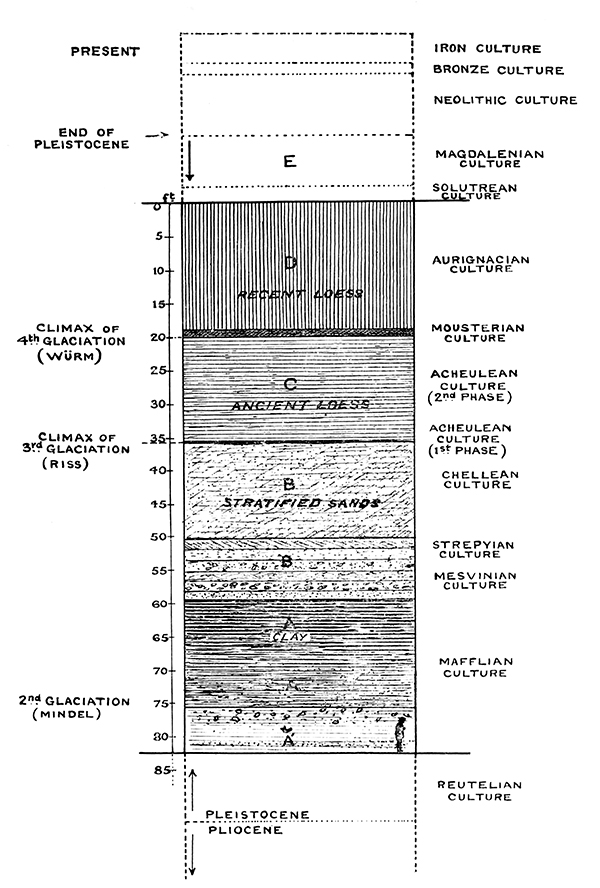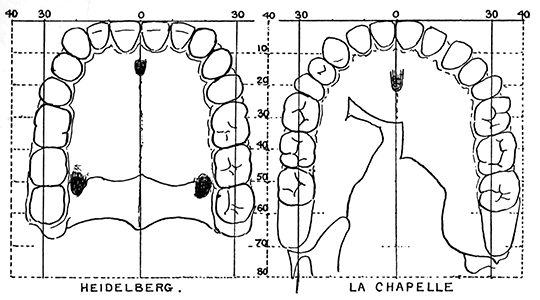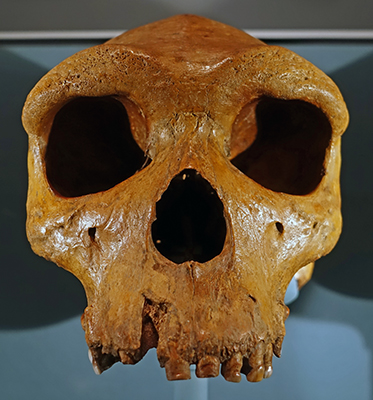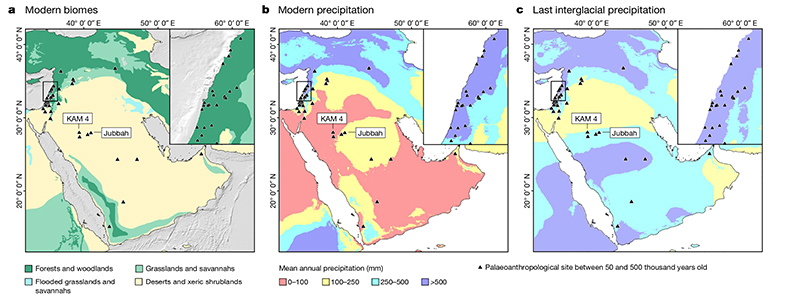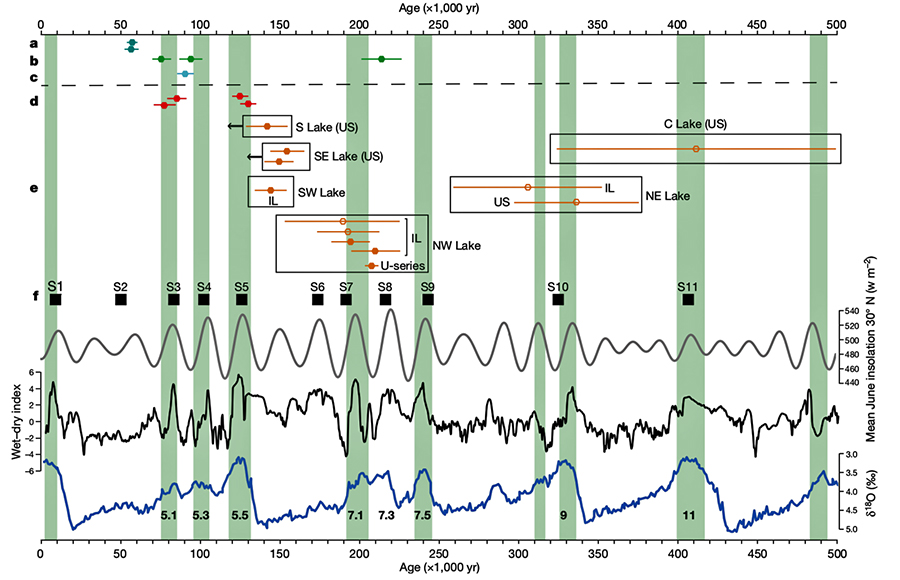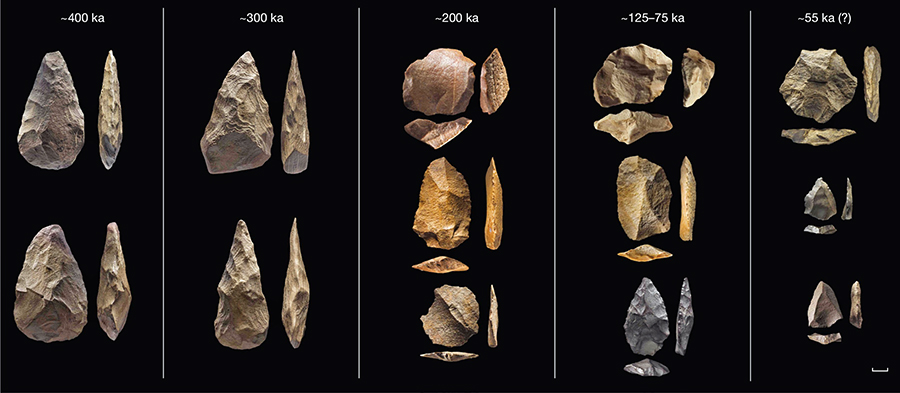Back to Don's Maps
 Back to Archaeological Sites
Back to Archaeological Sites
 Back to the review of hominins
Back to the review of hominins
Homo heidelbergensis
Homo heidelbergensis is an extinct species of the genus Homo which lived in Africa, Europe and western Asia from at least 600 000 years ago, and may date back 1 300 000 years. It survived until 200 000 to 250 000 years ago. It is probably the ancestor of Homo sapiens in Africa and the Neanderthals in Europe, and perhaps also the Denisovans in Asia. It was first discovered near Heidelberg in Germany in 1907 and named by Otto Schoetensack.Both H. antecessor and H. heidelbergensis are likely to be descended from the morphologically very similar Homo ergaster from Africa. But because H. heidelbergensis had a larger brain-case - with a typical cranial volume of 1100-1400 cm3 overlapping the 1350 cm3 average of modern humans - and had more advanced tools and behaviour, it has been given a separate species classification. Male heidelbergensis averaged about 5 ft 9 in (1.75 m) tall and 136 lb (62 kg). Females averaged 5 ft 2 in (1.57 m) and 112 lb (51 kg).
A reconstruction of 27 complete human limb bones found in Atapuerca (Burgos, Spain) has helped to determine the height of H. heidelbergensis compared to Homo neanderthalensis, the conclusion was that most H. heidelbergensis averaged about 170 cm (5ft 7in) in height and were only slightly taller than neanderthals.
According to Lee R. Berger of the University of Witwatersrand, numerous fossil bones indicate some populations of Heidelbergensis were "giants" routinely over 2.13 m (7 ft) tall and inhabited South Africa between 500 000 and 300 000 years ago. Recent findings in a pit in Atapuerca (Spain) of 28 human skeletons suggest that H. heidelbergensis may have been the first species of the Homo genus to bury their dead.
Some experts believe that H. heidelbergensis, like its descendant H. neandertalensis, acquired a primitive form of language. No forms of art or sophisticated artifacts other than stone tools have been uncovered, although red ochre, a mineral that can be used to create a red pigment which is useful as a paint, has been found at Terra Amata excavations in the south of France.
The morphology of the outer and middle ear suggests they had an auditory sensitivity similar to modern humans and very different from chimpanzees. They were probably able to differentiate between many different sounds. Dental wear analysis suggests they were as likely to be right-handed as modern people.
H. heidelbergensis was a close relative (most probably a migratory descendant) of Homo ergaster. H. ergaster is thought to be the first hominid to vocalize and that as H. heidelbergensis developed more sophisticated culture proceeded from this point.
500 000 year-old hafted stone points used for hunting are reported from Kathu Pan 1 in South Africa, tested by way of use-wear replication. This find could mean that modern humans and Neanderthals inherited the stone-tipped spear, rather than developing the technology independently.
Text above: Wikipedia
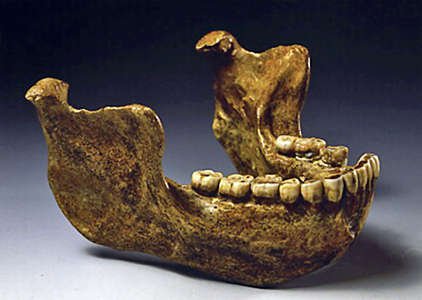
Homo heidelbergensis mandible.
Mauer is the type site of Homo heidelbergensis..
This is Mauer 1, a lower jaw discovered in 1907 in Mauer, near Heidelberg, Germany. This jaw is the 'type specimen' or official representative of this species. It was discovered by workers at a gravel quarry which had previously yielded many fossils of extinct mammals. Lying at a depth of about 24 metres, its age is estimated to be between 400 000 and 600 000 years old.
This species had a strongly built lower jaw for the attachment of strong chewing muscles. As with earlier hominins, the lower jaw did not have a protruding, pointed chin. The teeth were arranged in the jaw so that they formed a parabolic shape (curved at the front then splayed out toward the back) and were smaller than those of earlier species (but larger than those of modern humans).
Photo: http://www.sciencedirect.com/science/article/pii/S0277379110000156
Text: Adapted from http://australianmuseum.net.au/image/Mauer-Jaw-Homo-heidelbergensis-angled-view/
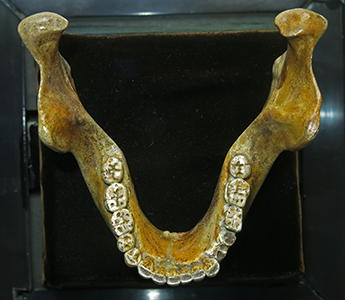
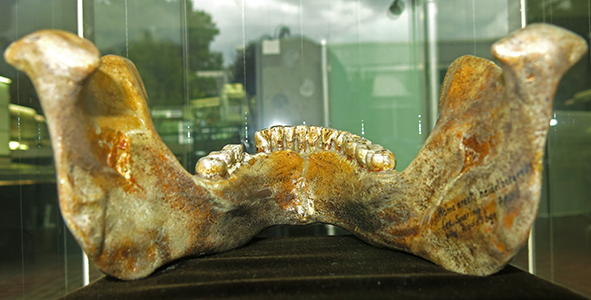
Homo heidelbergensis mandible.
Photo: Don Hitchcock 2014
Source: Facsimile, Museum of Geology and Palaeontology of the University of Heidelberg
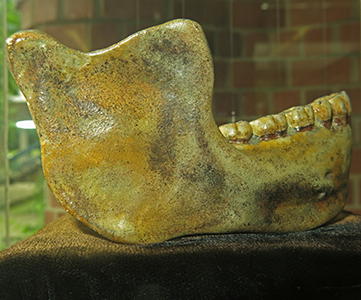
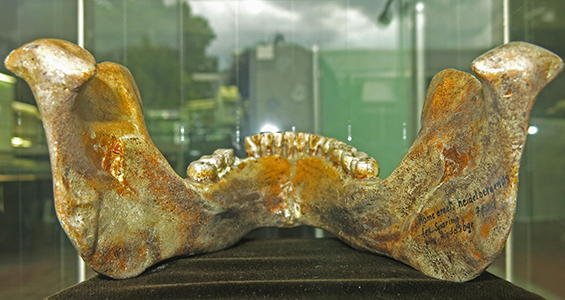
Homo heidelbergensis mandible.
Photo: Don Hitchcock 2014
Source: Facsimile, Museum of Geology and Palaeontology of the University of Heidelberg

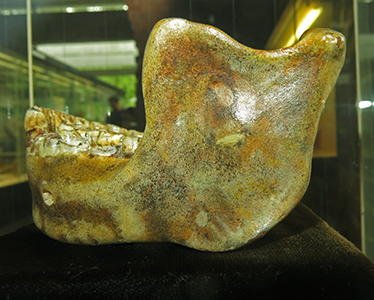
Homo heidelbergensis mandible.
Photo: Don Hitchcock 2014
Source: Facsimile, Museum of Geology and Palaeontology of the University of Heidelberg
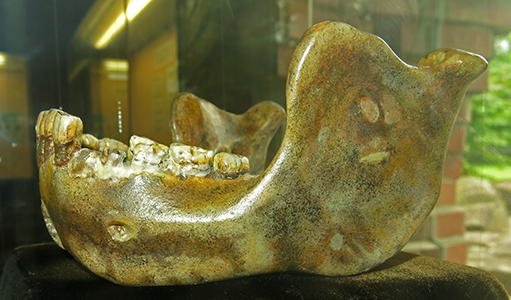

Homo heidelbergensis mandible.
Photo: Don Hitchcock 2014
Source: Facsimile, Museum of Geology and Palaeontology of the University of Heidelberg
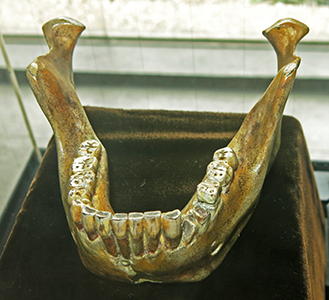
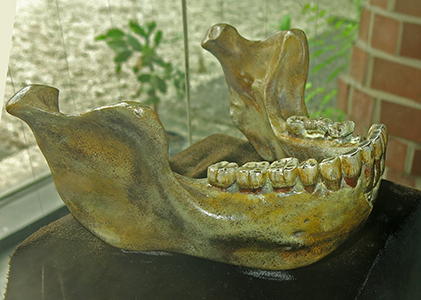
Homo heidelbergensis mandible.
Photo: Don Hitchcock 2014
Source: Facsimile, Museum of Geology and Palaeontology of the University of Heidelberg
Homo heidelbergensis
Cast of Arago 21 and Arago 13, a skull and lower jaw discovered in Arago Caves, Tautavel, France. Excavations since 1964 have revealed a number of human fossils at Arago including this skull and jaw from different individuals. Thousands of stone tools and the bones of many types of animals have also been uncovered at this site. The Arago 21 skull is relatively complete but it was distorted either before or during fossilisation. Its features are typical of this species but its size and robust facial features suggest that it is the skull of a young male. It has been dated as being between 250 000 and 400 000 years old. The Arago 47 parietal, discovered in 1979 in the Caune de l'Arago, in Tautavel, in the Pyrénées-Orientales fits perfectly with the Arago 21 face, discovered in 1971, making it possible to reconstruct the skull of the Tautavel Man.
Photo and text: Carl Bento © Australian Museum, http://australianmuseum.net.au/image/Arago-Skull-Homo-heidelbergensis-anged-view/
Homo heidelbergensis
This skull, Arago 21, EM2273-EM2278, from Arago Cave belonged to a young adult male. Other human fossils and artefacts found at the same site suggest that these people had large brains, strong muscular bodies, and the ability to hunt large animals using tools.
From Aragao Cave, Tautavel, France, circa 450 000 years old. Original in the Institute of Human Palaeontology, Paris.
Photo and text: facsimile, Natural History Museum, London
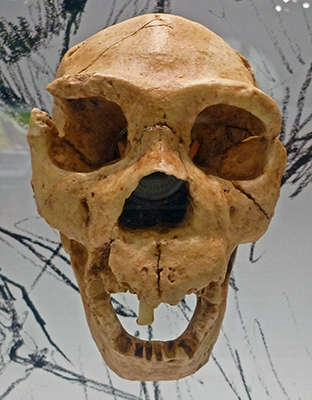
Homo heidelbergensis
Schädelfragmente (Abgüsse), Bilsingsleben, Deutschland, ca 423 000 - 362 000 Jahre
Cranial fragments (casts), Bilsingsleben, Deutschland, ca 423 000 - 362 000 BP
Photo: Ralph Frenken
Source: Museum of Natural History, Vienna, Austria
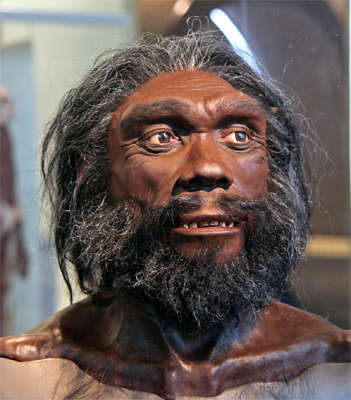
Model of the head and shoulders of an adult male Homo heidelbergensis on display in the Hall of Human Origins in the Smithsonian Museum of Natural History in Washington, D.C., created by John Gurche, a 'paleo-artist,' who has recreated strikingly realistic heads of our earliest human ancestors.
Abigail Tucker, 'A Closer Look at Evolutionary Faces', Smithsonian.com, February 25, 2010 writes:
Appearing 700 000 years ago, Homo heidelbergensis is closely related to our own species. 'It has huge brow ridges,' Gurche notes. 'A lot of people think that’s kind of a shock absorber for the face, that it dissipates pressure put on teeth at the front of the skull, if you are using your mouth as a clamp to grip implements or a skin.'
The huge brow ridges tempted Gurche to create a scowling expression, and in fact he had reason to believe that this particular individual wasn’t a happy camper: the model skull had nearly a dozen abscessed teeth. But 'I happened to catch him in a good mood,' Gurche says. 'I wanted that positive feeling to be somewhere in the line-up.'
Link: https://www.smithsonianmag.com/science-nature/a-closer-look-at-evolutionary-faces-8369070/
Photo: Tim Evanson
Permission: Creative Commons Attribution-Share Alike 2.0 Generic license.
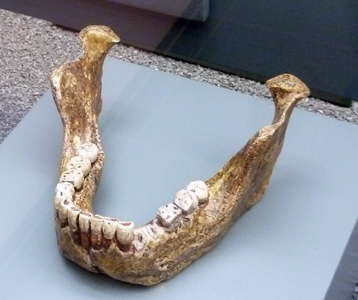
Lower jaw of Homo heidelbergensis, facsimile. This is the presumed ancestor of both Homo sapiens and Homo neanderthalensis, and is the type specimen for Homo heidelbergensis. It was found at Mauer, Rhein-Neckar-Kreis. Ca 600 000 BP.
The first fossil discovery of this species was made on October 21, 1907, and came from Mauer where the workman Daniel Hartmann spotted the jaw shown here in a sandpit. The jaw (Mauer 1) was in good condition except for the missing premolar teeth, which were eventually found near the jaw. The workman gave it to Professor Otto Schoetensack from the University of Heidelberg, who identified and named the fossil.
The next Homo heidelbergensis remains were found in Steinheim an der Murr, Germany (the Steinheim Skull, 350 000 BP); Arago, France (Arago 21); Petralona, Greece; and Ciampate del Diavolo, Italy.
Photo: R, 2012
Source: Museum of Karlsruhe, Inv. 2008/755
Text: Adapted from Wikipedia, and from the card with the exhibit.

Mandible (lower jaw) of the type specimen of Homo heidelbergenis from Mauer near Heidelberg, Germany (replica, Museum Mauer)
Photo: Gerbil
Permission: This file is licensed under the Creative Commons Attribution-Share Alike 3.0 Unported license.
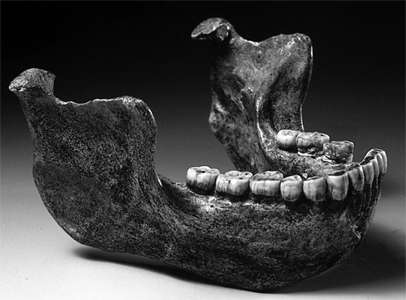
Mandible (lower jaw) of the type specimen of Homo heidelbergenis from Mauer near Heidelberg, Germany (replica, Museum Mauer)
Photo: http://www.pnas.org/content/107/46/19726/F1.expansion.html
Stratigraphy of the sand pit Grafenrain at Mauer with the find horizon of the Homo heidelbergensis mandible in the lower sands.
Left photograph is taken from the original monograph, with the find site (x); right photograph shows the present exposure.
Photo: http://www.pnas.org/content/107/46/19726/F2.expansion.html
Diagrammatic section of the strata of the sand pit at Mauer, showing the depth at which the mandible (A') was found.
( Note that this diagram appears to have been made with the photograph above at left in mind - there is a little figure of a man near the find site in both the photo and this
cross section - Don )
Drawing: after Schoetensack and Rutot
Photo: Keith (1915)
Proximal source: archive.org
Reconstruction of the palate of the Heidelberg man, compared with Professor Boule's reconstruction of the La Chapelle palate.
Photo: Keith (1915)
Proximal source: archive.org
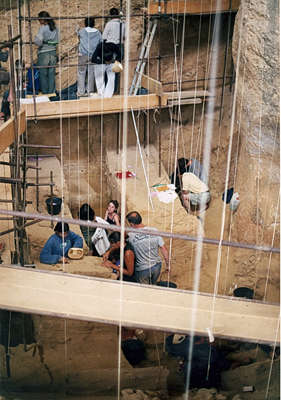
Arago Cave, near Tautavel (Perpignan-region), France
Summer 2002
Photo: Gerbil
Permission: Creative Commons Attribution-Share Alike 3.0 Unported license.
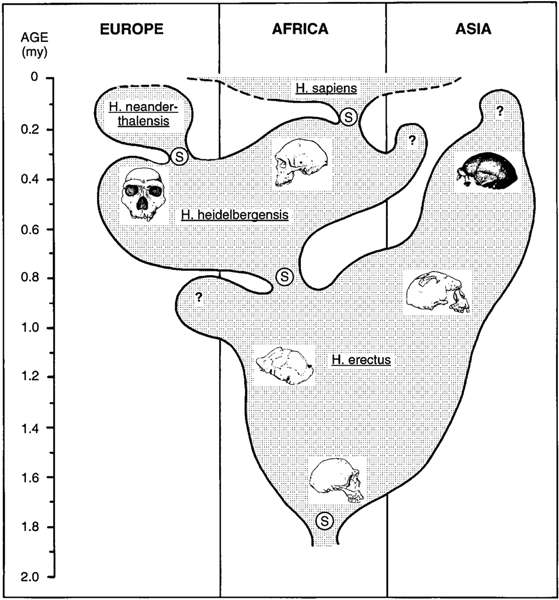
A tree illustrating the evolution and geographic distribution of Homo in the Pleistocene. Homo erectus is assumed to have originated in Africa and then spread quickly to Asia
and then to Europe.
Homo heidelbergensis is distributed from Africa into Eurasia during the Middle Pleistocene. Whether this species reached the Far East is still a question. European
Homo heidelbergensis gave rise to the Neanderthals, while an African branch of Homo heidelbergensis is ancestral to modern humans. Four speciation events (S) are depicted.
Photo and text: Rightmire (1998)

Homo heidelbergensis
Hominins from Africa, Europe and Asia that lived between about 600 000 and 1 million years ago, such as Homo heidelbergensis, continue the trends seen in earlier forms. They are characterised by larger brains, faces and teeth, with more robust bodies. They hunted a wide variety of game and entered various new environments not occupied by previous hominids. Their stone tools were still Acheulian hand axes and flakes, and their camp sites were simple and appear not to have been used repeatedly. However, the discovery of 400 000 year old finely crafted spears in Germany demonstrates their tool making proficiency.
Homo heidelbergensis
BH1 / Kabwe 1 (cranium)
Broken Hill, Zambia
Discovered by T. Zwigelaar, 1921
Photo: Don Hitchcock 2013
Source and text: Facsimile, Western Australian Museum
Discovered: 1921 in Kabwe (formerly Broken Hill), Zambia
This skull was the first fossil of a human ancestor to be discovered in Africa. It combines primitive features such as a wide face, thick arching brow ridges and a sloping forehead with a large brain capacity of 1280 cubic centimetres.
The date of this specimen has been confirmed by
Grün (2020) as being 299 000 BP.
This individual had significant tooth decay and a number of associated abscesses had decayed the upper jaw bone. Significant dental decay such as this was unusual in our ancestors prior to the development of agriculture approximately 10 000 years ago when more sugars and starchy foods were included in the diet.
Text above: http://australianmuseum.net.au/image/Kabwe-or-Broken-Hill-1-Homo-heidelbergensis-skull/
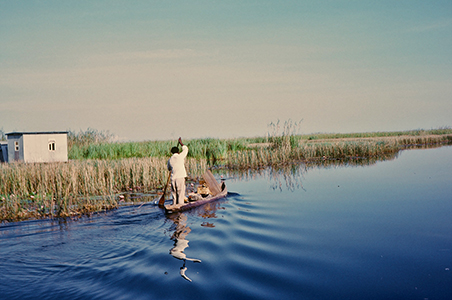
A resident fisherman enters Lukanga Swamp about 60 km west of Kabwe, Zambia. Fisher families live in papyrus shelters on floating mats of vegetation within the swamp. The national bird, the fish eagle, may be seen hunting for its prey in the swamp.
Photo: DBrianWilson
Permission:licensed under the Creative Commons Attribution 3.0
Homo heidelbergensis, BH1
Broken Hill, Zambia, 299 000 BP.
This was the first early human fossil discovered in Africa. It has a wide face, large brow ridge and a large brain capacity of 1 280 cm3, as large as many humans today. thick bony ridges at the back of the skull would have supported strong neck muscles.
Searching for metal ore deposits in the limestone caves of Kabwe, Zambia, Swiss miner Tom Zwiglaar is credited with finding the first early human fossil ever to be discovered in Africa. When Kabwe (also known as Broken Hill, Broken Hill 1, and BH1) was sent to Arthur Smith Woodward, Woodward assigned the specimen to a new species: Homo rhodesiensis. Today, most scientists assign Kabwe to Homo heidelbergensis.
Photo: Don Hitchcock 2018
Source and text: Facsimile, Natural History Museum, London
Additional text: https://humanorigins.si.edu/evidence/human-fossils/fossils/kabwe-1
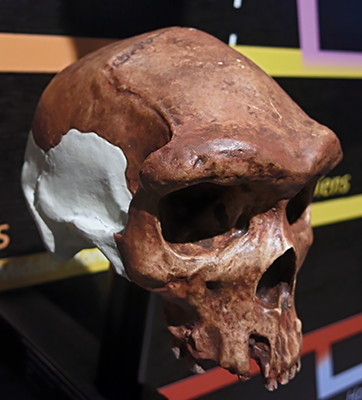
Homo heidelbergensis, Broken Hill 1.
299 000 BP, Kabwe, Zambia.
Photo: Don Hitchcock 2015
Source: Facsimile, LVR-Landesmuseum Bonn, Germany

Homo heidelbergensis
Cranium 5 is one of the most important discoveries in the Sima de los Huesos, Atapuerca (Spain). The mandible of this cranium appeared, nearly intact, some years after its find, close to the same location.
Original
Photo: José-Manuel Benito Álvarez
Permission: Creative Commons Attribution-Share Alike 2.5 Generic license
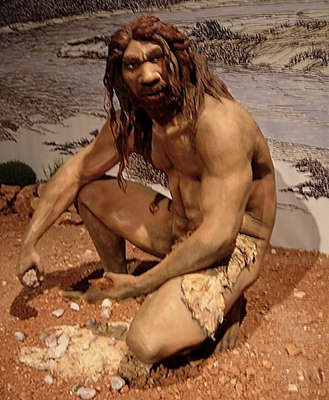
Homo heidelbergensis reconstruction
Photo: José Luis Martinez Álvarez
Permission: Creative Commons Attribution-Share Alike 2.5 Generic license

Homo heidelbergensis reconstruction
Photo: Cicero Moraes
Permission: Creative Commons Attribution-Share Alike 3.0 Unported license
Research reveals humans ventured out of Africa repeatedly as early as 400 000 years ago, to visit the rolling grasslands of Arabia

The Nefud Desert in Saudi Arabia
Photo: Eleanor Scerri
Proximal source: https://theconversation.com/
Eleanor Scerri, head of the Pan-African Evolution Research Group at the Max Planck Institute for the Science of Human History in Jena, Germany, and one of the authors of Groucutt et al. (2021) in https://theconversation.com/ reports on her article in nature, Groucutt et al. (2021) , which finds the oldest dated evidence for hominins in Arabia, in the form of stone tools dated to about 400 000 years ago.
( note that the authors do not specify which group of hominins produced the artefacts found. This determination is difficult without DNA evidence, since handaxes possibly attributable to Homo heidelbergensis were found, while other tools of the Levallois tradition point to Neanderthals. In any case, there is considerable overlap of datings where both attributions are possible. - Don )
Eleanor Scerri writes:
If you stood in the middle of the Nefud Desert in central Arabia today, you’d be confronted on all sides by enormous sand dunes, some rising more than 100 metres from the desert floor.
The few scraggly bushes make poor browse for the herds of goats and camels that eke out a living in this harsh environment. But this wasn't always the case.
Our research published today in Nature shows that in repeated pulses over the past 400 000 years, the Nefud Desert landscape received monsoon rains that resulted in rolling grasslands, flowing rivers and large lakes home to thousands of wild donkeys, antelopes and hippos.
Humans also inhabited these green corridors as they made their way out of Africa, only to disappear when conditions deteriorated again.
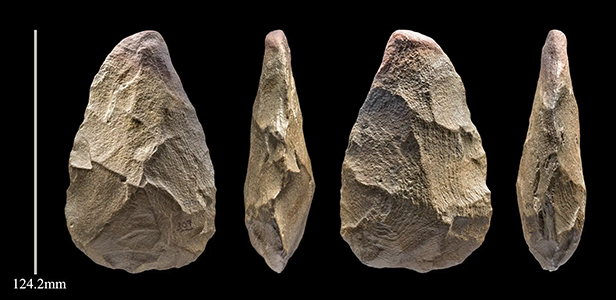
A 400 000 year old handaxe from Khall Amayshan 4.
( note the layering of the material of this handaxe. It may be a variety of silcrete, indurated sandstone - Don )
Photo: Ian Cartwright
Source: Palaeodeserts Project
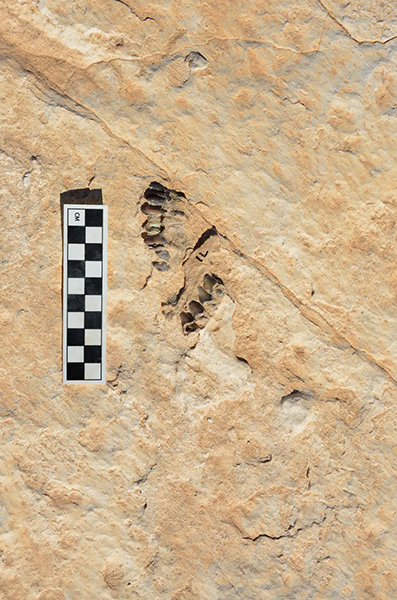
Antelope teeth eroding from an ancient lakebed in the Nefud Desert.
Photo: Julien Louys
Proximal source and text: https://theconversation.com/
Palaeoanthropological sites in Southwest Asia dating to between 50 and 500 ka.
a. Sites plotted on a map of modern biomes.
b. Sites plotted on map of modern precipitation.
c. Sites plotted on model of MIS 5e precipitation34, as an illustration of the changes that occurred during humid periods.
Photo and text: Groucutt et al. (2021)
The chronology and environmental context of hominin occupations in northern Arabia.
a. Al Marrat 327.
b. Jebel-Qattar 128.
c. Al Wusta20.
d. JSM 1 (present study).
e. Central (C), Northeast (NE), Northwest (NW), Southwest (SW), Southeast (SE) and South (S) lakes at KAM 4.
US, an age for sands underlying the lake (that is, a maximum age for overlying phase of lake formation);
IL, in lake (direct date on sediments within lake-related deposits). Black arrows pointing to the left (Southeast and South Lakes) reflect that the luminescence ages provide maximum ages, and the overlying lakes are younger. Filled symbols show quartz ages and open symbols show feldspar ages.
f. East Mediterranean sapropel record35, insolation36 (grey), monsoon index37 (black) and oxygen isotope record38 (blue). Southern Arabian humid periods are defined by speleothems in green21. Luminescence ages are presented with 1σ uncertainties and the single U-series age is presented with a 2σ uncertainty.
Photo and text: Groucutt et al. (2021)
Stone tools from KAM4 and Jebel Umm Sanman 1 (JSM1).
From left to right:
Assemblage A, KAM4 (approximately400ka)
Assemblage B, KAM4 (approximately 300 ka)
assemblage C, KAM 4 (approximately 200 ka)
Assemblage D (Southeast Lake, approximately 125–75 ka)
Assemblage E, KAM 4 (approximately 55 ka?)
Scale bar, 1 cm.
Photo and text: Groucutt et al. (2021)
Hominin timeline.
Note that Homo floresiensis has not been placed on this timeline. van den Bergh et al. (2016) indicate that it may be a form of Homo erectus.
Photo: © National Geographic, Jason Treat, NGM staff
Source: Lee Berger, University of the Witwatersrand (WITS), John Hawks, University of Wisconsin-Madison
Proximate source: http://news.nationalgeographic.com/2017/05/homo-naledi-human-evolution-science/
References
- Groucutt, H., et al., 2021: Multiple hominin dispersals into Southwest Asia over the past 400 000 years, https://doi.org/10.1038/s41586-021-03863-y September 2021
- Grün R. et al., 2020: Dating the skull from Broken Hill, Zambia, and its position in human evolution, Nature, 580, 372–375 (2020). https://doi.org/10.1038/s41586-020-2165-4
- Keith, A. , 1915: The Antiquity of man, Philadelphia: J.B. Lippincott company; London: Williams and Norgate
- Rightmire G., 1998: Human evolution in the Middle Pleistocene: The role of Homo heidelbergensis, Evol. Anthropol., 6: 218–227. doi: 10.1002/(SICI)1520-6505(1998)6:6<218::AID-EVAN4>3.0.CO;2-6
- van den Bergh G. et al., 2016: Homo floresiensis-like fossils from the early Middle Pleistocene of Flores, Nature, 534 (7606): 245–248. doi:10.1038/nature17999. PMID 27279221.
Back to Don's Maps
 Back to Archaeological Sites
Back to Archaeological Sites 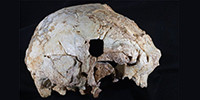 The recently found oldest fossil human cranium in Portugal marks an important contribution to the knowledge of human evolution during the middle Pleistocene in Europe and to the origin of the Neandertals. This cranium of Homo heidelbergensis represents the westernmost human fossil ever found in Europe during the middle Pleistocene epoch and one of the earliest on this continent to be associated with the Acheulean stone tool industry.
The recently found oldest fossil human cranium in Portugal marks an important contribution to the knowledge of human evolution during the middle Pleistocene in Europe and to the origin of the Neandertals. This cranium of Homo heidelbergensis represents the westernmost human fossil ever found in Europe during the middle Pleistocene epoch and one of the earliest on this continent to be associated with the Acheulean stone tool industry.
